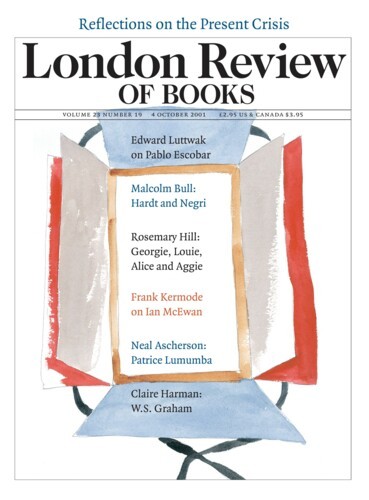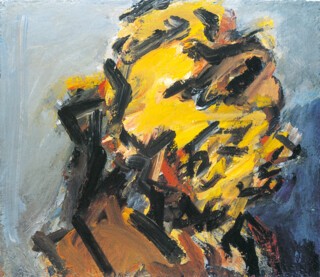Frank Auerbach is a serious painter. His retrospective at the Royal Academy, which has given over its main rooms to a show spanning nearly fifty years of his work, is a serious exhibition.1 The pictures themselves signal it with heavy colour: first, black, grey, brown, mud and rust, and, in later pictures strong reds and yellows (when he could afford it – earth colours are cheap). Thick paint – in early pictures so thick that it seems to parody all its Expressionist precursors – and wide strokes add weight to the message. The loaded brushmarks make some of the landscapes and portraits look like maniacally energetic variations on other, directly painted (sometimes merely decorative) work – a Constable landscape study, say, or even a Sargent portrait sketch. More obviously, the physicality of the pictures makes an emphatic claim on a central tradition of oil painting (think of it as a director seeking broader gestures from actors to renew old speeches): it is as though a Rembrandt-like stickiness of paint or a Hals-like dash has been multiplied by some large factor.
These signals of seriousness in the work are reinforced by what one reads of the life. Auerbach has worked in the same studio for most of it, has used friends and family as models, often painting the same person many times, each picture often requiring many sittings. His landscapes are made from drawings done in the early, empty morning of streets and open spaces near his studio. This use of what is intimate and close-by as subject matter has contemporary resonances (Francis Bacon, Lucian Freud) and historical ones (from Chardin’s studio-bound way of working to Cézanne’s Provençal landscape beat, and the dusty, unchanging workspaces of Giacometti and Morandi). The dedication of life to work suggests that art is a long and difficult calling. Accounts of the way he works – energetic moves towards the canvas to place a mark, a day’s work very often scraped back if it does not satisfy him – can be matched elsewhere (and in unlikely places: Whistler, too, believed in scraping down and starting over to achieve the right, spontaneous mark). They always point to effort and the belief that results do not come easily. At the heart of Auerbach’s practice are two notions. First, that it is no good doing what has been done before, that you must offer the world something original. And, second, that the human face, the human body and the world outside your own front door are subjects (perhaps now the only subjects) in which the old art of painting can still operate at full power.
These works, which can seem to parody the Old Masters they bring to mind, have themselves been parodied – or at least been the subject of ironic homage – in Glenn Brown’s illusionistic versions of Auerbach’s surfaces. But for all their scrunchings and scribblings one has the strong impression that the portraits (and the landscapes, too, come to that) are good likenesses. They seem more probable to be true the longer you look at them: allowing time for the brushmarks to take on their status as visual clues, to be matched in the databanks of the face-recognition bits of the brain. One is assisted in this by the undistorted nature of the underlying geometry. If you projected a photograph of the pose over the painting, the features would come more or less in the right place (which they would be less likely to do in, say, a Bacon portrait, although Bacon actually worked from photographs). The brushstrokes are boldly direct, but their energy comes from the fact that each one seems to relate to an observation of the way light shapes a particular feature, as well as from their kinetic extravagance.
Auerbach’s achievement is formidable. Unlike his teacher, David Bomberg, whose diverse stylistic excursions seem to test his talent as though he feared he had missed its true direction, Auerbach has followed a single line. His life’s work hangs together – the most recent pictures developing ideas about painting which are implicit in the earliest ones. Despite the pervading seriousness you can take a child-like pleasure in the squishiness of the paint (or, to be fair, when in adult mode, find it altogether too messy). But the slurp is balanced by a stiffness in both the landscapes and the portrait drawings, where most of the structures are defined by straight lines – or straight lines joined in zigzags. In the thickest earliest landscapes, they run like trenches across a muddy battlefield, to create a spatial scaffolding. In the portrait drawings the short, sharp lines create a jazzy syncopation. So there is the pleasure of discipline and of free expression.
Put these pleasures aside for a moment and return to ‘seriousness’. For what variety of seriousness can Auerbach’s work stand as an example? Not the seriousness of history painting, which enlarges our sense of the nature of a drama. Nor that of polemical painting, which draws us into an argument about the plight of people around us. Only, perhaps, the kind which looks to the practice of painting for a more complete experience of the physical world – one which makes it strange and new.
When you come into contact with still other kinds of seriousness you become aware of the corner the visual arts have retreated – been edged – into. At the National Gallery the surviving panels of Masaccio’s Pisa Altarpiece have been gathered together.2 The gestures of the figures round the crucified Christ make all the religious art which followed seem self-conscious and knowing. No wonder our moment does not allow directness of that kind. At the Saatchi Gallery, Boris Mikhailov’s photographs of the Russian homeless are shocking, as people on our own streets are, and shocking in a more straightforward way because he often shows them naked or exposing themselves; but also, and quite differently, shocking because in the big white Saatchi space they must be seen as art, and as art they can do very little about the bad things they show.3 Mikhailov says that it came to him that his coloured photographs were ‘like a rash on the ill body’ – the body of the new Russian state. His comments, which acknowledge the ambiguity of the position he has put himself in are interesting, but do nothing to assuage a kind of disgust at seeing such sorrow made so smart. It may be akin to Mikhailov’s own disgust at the situation he records. We now see so much, and know so much about how what we see can be adjusted to engage our attention, that no presentation of Mikhailov’s sort of truth can ever seem simple again. Only the solipsistic modes – abstraction, this is what I see, this is who I am – can hope to go into the world unglossed and to be looked at for themselves alone. Auerbach’s pictures show how this can work. It seems unlikely that even his vein, which depends for much of its force on a relationship with past art, can be mined much longer. We are, perhaps, too knowing about art ever to be simply serious again.
Send Letters To:
The Editor
London Review of Books,
28 Little Russell Street
London, WC1A 2HN
letters@lrb.co.uk
Please include name, address, and a telephone number.


